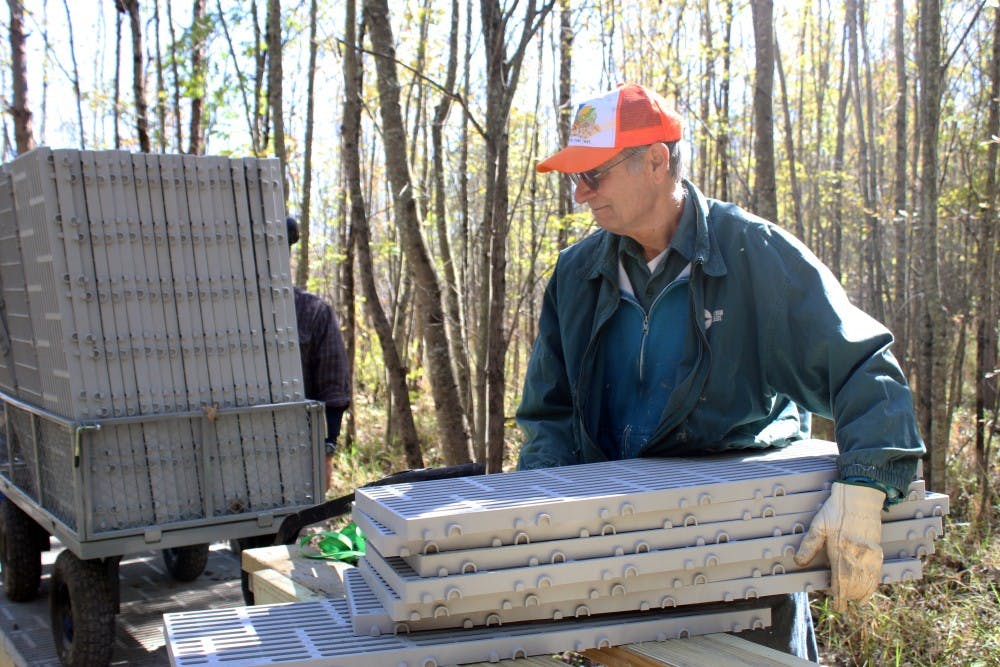The red port-a-potty was the first sign of civilization on the gravel trail.
About a half-mile into the Beanblossom Bottoms Nature Preserve, the full immersion of the trees fades away into a small camp. There are a couple of trucks and a tent, stocked with supplies and manpower. Off the gravel trail is the beginning of a boardwalk trail, elevated slightly and made of plastic. At the base, men and women pack the boardwalk trail’s materials onto wagons to lug them out to the end.
Beneath the trail is a small stream, called Beanblossom Creek. It’s only a few inches deep, but minnows swim up and down. In the tall grassy field beyond the trail, a temporary sign pointing out a bald eagles’ nest in a distant tree is stuck in the mud.
At the end of the trail, a group of men work to extend it. They install long metal poles to guide the trail and put the plastic decking for people to walk on.
"When we own land, we have to preserve it,” said Abby Henkel, Communications Director of Sycamore Land Trust, a conservation nonprofit that owns this land.
So when the old trail in the nature preserve, which was wooden and sat in the water, began rotting, flooding and becoming too slippery to walk on, Sycamore Land Trust had to replace it.
“Most construction projects don’t take place in the wetlands,” said John Lawrence, interim Executive Director of Sycamore Land Trust.
The project posed many problems. Sycamore Land Trust had to figure out how to get enough people to help with the project, how to build a trail that doesn’t rot and how to transport long materials around the trail’s tight turns.
First, Sycamore Land Trust took on extra staff. To build the trail, Land Stewardship Manager Chris Fox is working with temporary workers from Tradesmen International and workers from Loren Woods Builders. When they had to tear the road out, Sycamore Land Trust brought in inmates from the Department of Corrections to help.
Fox was nervous at first to work with the inmates, but he said they ended up being hard workers and nice people.
Sycamore Land Trust also used volunteers to add workers.
Sycamore Land Trust was founded in 1990. It was run on a volunteer basis for 10 years, but has since grown to include seven full-time staff. Still, it maintains its original spirit by holding monthly volunteer events, called Third Thursdays. On the third Thursday each month, the local community is invited to help work on preservation.
Last Thursday, the monthly volunteer program was held at Beanblossom Bottoms to work on the trail.
Kate Mulligan, a recent retiree, was one of the volunteers.
Mulligan worked in a plant nursery, and this love for nature is why she has volunteered consistently since the program began. She usually comes alone.
“A lot of my friends aren’t into hiking and nature as much as I am,” Mulligan said.
Still, she looks forward to helping out for the sake of being in nature and having a role in conservation efforts.
Volunteers helped the permanent crew by moving materials to them from the beginning of the trail to the end. They’ve built a decent amount of the trail, so lugging materials out to the end takes a long time.
To build a trail that doesn’t rot or flood, Sycamore Land Trust looked to docks.
Although the water is only a few inches deep, Beanblossom Creek empties into the White River, which is used as a source of drinking water, Henkel said. The new trail needed to preserve that water while still allowing people to experience the creek.
Sycamore Land Trust ended up purchasing plans and materials from a dock company in Maine, Fox said.
“This water is why a plastic boardwalk like this is so important,” Henkel said.
The dock used wouldn't float, but it has the same principle and it won’t disturb the water. These materials were what the volunteers were moving at the volunteer event.
Another issue was moving these dock materials around the trail’s tight corners. The solution came from fire trucks.
One night, Fox said, as he was falling asleep, he remembered how fire trucks were built in the 1960s. One man would drive the front of the truck, and another would drive the back half so the trucks could get around tight city corners.
The next day, he and his team built a new wagon that steered in the front and the back.
At the end of the volunteer day, Mulligan rolled a wagon down the plastic boardwalk trail carrying more dock materials. When she reached the end, a group of men, including the Tradesmen workers, Fox and Sycamore’s interim executive director, John Lawrence, began to move the wagon.
They grabbed the sides, almost dropping it in the mud as they lugged it to the ground. They wheeled the wagon to a grassy area and started unloading the plastic boards.
“It’s so nice and quiet out here,” Lawrence said.
“Yeah that’s what everyone says,” Fox said.
Beyond these men, the soft hum of crickets filled the air and save for two turkey vultures, the sky was clear.
It seemed peaceful, but a creative process with many complications got them to this point.
“It’s not a walk in the park,” Fox said. “Well actually it is. But it’s a hard walk in the park.”
But he said it will be worth it when it's completed at the end of the year.
“People might not know who did it or when they did it,” he said. “But we know they’ll enjoy it.”






